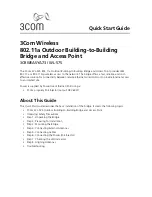
50
|
Chapter 4. Customizing Your Network Settings
N150 Wireless Router WGR614v11 User Manual
•
Subnet mask.
255.255.255.0
These addresses are part of the designated private address range for use in private networks
and should be suitable for most applications. If your network has a requirement to use a
different IP addressing scheme, you can make those changes in this screen.
The LAN IP settings are:
•
IP Address
. The LAN IP address of the router.
•
IP Subnet Mask
. The LAN subnet mask of the router. Combined with the IP address, the
IP subnet mask allows a device to know which other addresses are local to it, and which
must be reached through a gateway or router.
•
RIP Direction
. RIP allows a router to exchange routing information with other routers.
The RIP Direction selection controls how the router sends and receives RIP packets.
Both
is the default.
-
When set to
Both
or
In Only
, the router incorporates the RIP information that it
receives.
-
When set to
Both
or
Out Only
, the router broadcasts its routing table periodically.
•
RIP Version
. This controls the format and the broadcasting method of the RIP packets
sent by the router. (It recognizes both formats when receiving.) The default setting is
Disabled
.
-
RIP-1
is universally supported. RIP-1 is usually adequate unless you have an unusual
network setup.
-
RIP-2B
carries more information than RIP-1 and uses subnet broadcasting.
-
RIP-2M
carries more information than RIP-1 and uses multicasting.
Using the Router as a DHCP Server
By default, the router functions as a DHCP server, allowing it to assign IP, DNS server, and
default gateway addresses to all computers connected to the router’s LAN. The assigned
default gateway address is the LAN address of the router. The router assigns IP addresses to
the attached computers from a pool of addresses specified in this screen. Each pool address
is tested before it is assigned to avoid duplicate addresses on the LAN.
Note:
For most applications, the default DHCP and TCP/IP settings of the
router are satisfactory. Click the link to the online document
Wireless
Networking Basics
in Appendix
A for an explanation of DHCP and
information about how to assign IP addresses for your network.
To specify a pool of IP addresses to be assigned, set the starting IP address and ending IP
address. These addresses should be part of the same IP address subnet as the router’s LAN
IP address. Using the default addressing scheme, you should define a range between
192.168.1.2
and
192.168.1.254
, although you might wish to save part of the range for
devices with fixed addresses.
















































